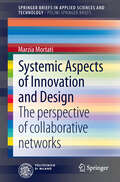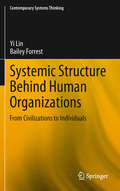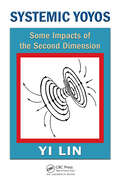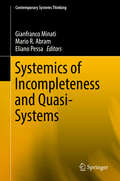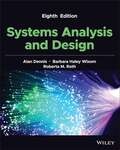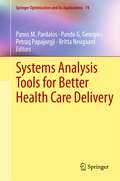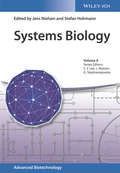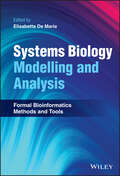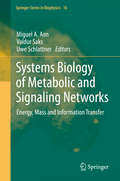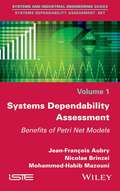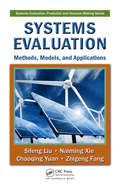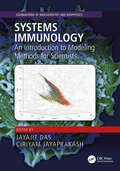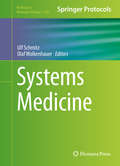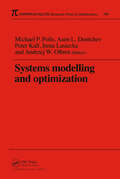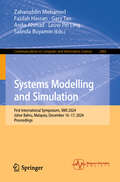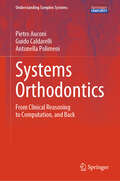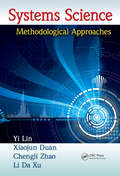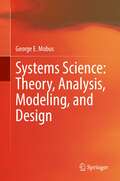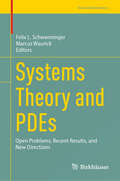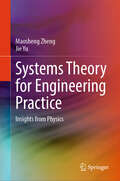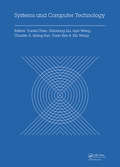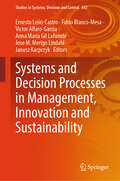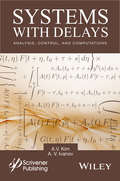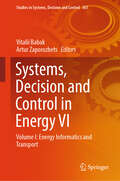- Table View
- List View
Systemic Aspects of Innovation and Design
by Marzia MortatiThe book provides a snapshot of a hot topic - the systemic nature of innovation and its relevance to design - with a trifold perspective: the academic level - the literature on innovation studies and design is often neglected and a clear connection between the two topics taken for granted; the research level - collaborative models are currently considered great opportunities for transforming consumption, production and distribution of goods, but a clear scholarly discourse is still forming; the political level - the European Commission and the OECD are devoting much effort to understanding and measuring the impact of design in innovation processes and firms and a clear contribution would greatly support this path. Thus the book provides an informed, historical and nuanced perspective to the relationship between design and innovation to contribute to all three levels and to propose a point of view that goes beyond aesthetics and meanings.
Systemic Structure Behind Human Organizations
by Bailey Forrest Yi LinSystemic Structure behind Human Organizations: From Civilizations to Individuals shows how the systemic yoyo model can be successfully employed to study human organizations at three different levels: civilizations, business enterprises, and individuals. This monograph tackles managerial problems from an holistic perspective such as how a business entity grows and dies and how a CEO can manipulate the choices of long- and short-term projects in order to gain more control over the board of directors. By creating a uniform language and logic of reasoning, the book provides examples and convincing results. Additionally the book shows how the same model, thinking logic, and methodology of the systems research can be equally applied to analyze problems and situations considered in natural sciences, social sciences, and humanity areas. Therefore it offers knowledge of a brand new tool to attack organizational problems. By concentrating on difficult, unsettled issues in these varying areas, this monograph thoroughly explains how some laws of nature can be established for the common study of natural and social sciences.
Systemic Yoyos: Some Impacts of the Second Dimension (Systems Evaluation, Prediction, and Decision-Making)
by Yi LinA Novel Method to Analyze Problems and Encourage Systemic ThinkingReal-Life Case Studies Illustrate the Application of the Systemic Yoyo Model in Diverse AreasWritten by the co-creator of the systemic yoyo model, Systemic Yoyos: Some Impacts of the Second Dimension shows how the yoyo model and its methodology can be employed to study many unsettled
Systemics of Incompleteness and Quasi-Systems (Contemporary Systems Thinking)
by Gianfranco Minati Mario R. Abram Eliano PessaThis book contains the proceedings of the Seventh National Conference of the Italian Systems Society. The title, Systemics of Incompleteness and Quasi-Systems, aims to underline the need for Systemics and Systems Science to deal with the concepts of incompleteness and quasiness. Classical models of Systemics are intended to represent comprehensive aspects of phenomena and processes. They consider the phenomena in their temporal and spatial completeness. In these cases, possible incompleteness in the modelling is assumed to have a provisional or practical nature, which is still under study, and because there is no theoretical reason why the modelling cannot be complete. In principle, this is a matter of non-complex phenomena, to be considered using the concepts of the First Systemics. When dealing with emergence, there are phenomena which must be modelled by systems having multiple models, depending on the aspects being taken into consideration. Here, incompleteness in the modelling is intrinsic, theoretically relating changes in properties, structures, and status of system. Rather than consider the same system parametrically changing over time, we consider sequences of systems coherently. We consider contexts and processes for which modelling is incomplete, being related to only some properties, as well as those for which such modelling is theoretically incomplete—as in the case of processes of emergence and for approaches considered by the Second Systemics. In this regard, we consider here the generic concept of quasi explicating such incompleteness. The concept of quasi is used in various disciplines including quasi-crystals, quasi-particles, quasi-electric fields, and quasi-periodicity. In general, the concept of quasiness for systems concerns their continuous structural changes which are always meta-stable, waiting for events to collapse over other configurations and possible forms of stability; whose equivalence depends on the type of phenomenon under study. Interest in the concept of quasiness is not related to its meaning of rough approximation, but because it indicates an incompleteness which is structurally sufficient to accommodate processes of emergence and sustain coherence or generate new, equivalent or non-equivalent, levels. The conference was devoted to identifying, discussing and understanding possible interrelationships of theoretical disciplinary improvements, recognised as having prospective fundamental roles for a new Quasi-Systemics. The latter should be able to deal with problems related to complexity in more general and realistic ways, when a system is not always a system and not always the same system. In this context, the inter-disciplinarity should consist, for instance, of a constructionist, incomplete, non-ideological, multiple, contradiction-tolerant, Systemics, always in progress, and in its turn, emergent.
Systems Analysis And Design
by Alan Dennis Roberta M. Roth Barbara WixomSystems Analysis and Design, 8th Edition offers students a hands-on introduction to the core concepts of systems analysis and systems design. Following a project-based approach written to mimic real-world workflow, the text includes a multitude of cases and examples, in-depth explanations, and special features that highlight crucial concepts and emphasize the application of fundamental theory to real projects.
Systems Analysis Tools for Better Health Care Delivery
by Panos M. Pardalos Petraq Papajorgji Pando G. Georgiev Britta NeugaardThis book presents some recent systems engineering and mathematical tools for health care along with their real-world applications by health care practitioners and engineers. Advanced approaches, tools, and algorithms used in operating room scheduling and patient flow are covered. State-of-the-art results from applications of data mining, business process modeling, and simulation in healthcare, together with optimization methods, form the core of the volume. Systems Analysis Tools for Better Health Care Delivery illustrates the increased need of partnership between engineers and health care professionals. This book will benefit researchers and practitioners in health care delivery institutions, staff members and professionals of specialized hospital units, and lecturers and graduate students in engineering, applied mathematics, business administration and health care.
Systems Biology
by Jens Nielsen Gregory Stephanopoulos Sang Yup Lee J. Nielsen Stefan HohmannComprehensive coverage of the many different aspects of systems biology, resulting in an excellent overview of the experimental and computational approaches currently in use to study biological systems. Each chapter represents a valuable introduction to one specific branch of systems biology, while also including the current state of the art and pointers to future directions. Following different methods for the integrative analysis of omics data, the book goes on to describe techniques that allow for the direct quantification of carbon fluxes in large metabolic networks, including the use of 13C labelled substrates and genome-scale metabolic models. The latter is explained on the basis of the model organism Escherichia coli as well as the human metabolism. Subsequently, the authors deal with the application of such techniques to human health and cell factory engineering, with a focus on recent progress in building genome-scale models and regulatory networks. They highlight the importance of such information for specific biological processes, including the ageing of cells, the immune system and organogenesis. The book concludes with a summary of recent advances in genome editing, which have allowed for precise genetic modifications, even with the dynamic control of gene expression. This is part of the Advances Biotechnology series, covering all pertinent aspects of the field with each volume prepared by eminent scientists who are experts on the topic in question.
Systems Biology Modelling and Analysis: Formal Bioinformatics Methods and Tools
by Elisabetta De MariaSystems Biology Modelling and Analysis Describes important modelling and computational methods for systems biology research to enable practitioners to select and use the most suitable technique Systems Biology Modelling and Analysis provides an overview of state-of-the-art techniques and introduces related tools and practices to formalize models and automate reasoning for systems biology. The authors present and compare the main formal methods used in systems biology for modelling biological networks, including discussion of their advantages, drawbacks, and main applications. Each chapter includes an intuitive presentation of the specific formalism, a brief history of the formalism and of its applications in systems biology, a formal description of the formalism and its variants, at least one realistic case study, some applications of formal techniques to validate and make deep analysis of models encoded with the formalism, and a discussion on the kind of biological systems for which the formalism is suited, along with concrete ideas on its possible evolution. Edited by a highly qualified expert with significant experience in the field, some of the methods and techniques covered in Systems Biology Modelling and Analysis include: Petri nets, an important tool for studying different aspects of biological systems, ranging from simple signaling pathways to metabolic networks and beyond Pathway Logic, a formal, rule-based system and interactive viewer for developing executable models of cellular processes Boolean networks, a mathematical model which has been widely used for decades in the context of biological regulation networks Answer Set Programming (ASP), which has proven to be a strong logic programming paradigm to deal with the inherent complexity of biological models For systems biologists, biochemists, bioinformaticians, molecular biologists, pharmacologists, and computer scientists, Systems Biology Modelling and Analysis is a comprehensive all-in-one resource to understand and harness the field’s current models and techniques while also preparing for their potential developments in coming years with the help of the author’s expert insight.
Systems Biology of Metabolic and Signaling Networks
by Miguel A. Aon Valdur Saks Uwe SchlattnerSystems Biology represents a new paradigm aiming at a whole-organism-level understanding of biological phenomena, emphasizing interconnections and functional interrelationships rather than component parts. The study of network properties, and how they control and regulate behavior from the cellular to organism level, constitutes a main focus of Systems Biology. This book addresses from a novel perspective a major unsolved biological problem: understanding how a cell works and what goes wrong in pathology. The task undertaken by the authors is in equal parts conceptual and methodological, integrative and analytical, experimental and theoretical, qualitative and quantitative, didactic and comprehensive. Essentially, they unravel the spatio-temporal unfolding of interacting mass-energy and information networks at the cellular and organ levels, as well as its modulation through activation or repression by signaling networks to produce a certain phenotype or (patho)physiological response. Starting with the historical roots, in thirteen chapters this work explores the Systems Biology of signaling networks, cellular structures and fluxes, organ and microorganism functions. In doing so, it establishes the basis of a 21st century approach to biological complexity.
Systems Biology: Modeling, Analysis, and Simulation (Lecture Notes on Mathematical Modelling in the Life Sciences)
by Jinzhi LeiThis book discusses the mathematical simulation of biological systems, with a focus on the modeling of gene expression, gene regulatory networks and stem cell regeneration. The diffusion of morphogens is addressed by introducing various reaction-diffusion equations based on different hypotheses concerning the process of morphogen gradient formation. The robustness of steady-state gradients is also covered through boundary value problems. The introduction gives an overview of the relevant biological concepts (cells, DNA, organism development) and provides the requisite mathematical preliminaries on continuous dynamics and stochastic modeling. A basic understanding of calculus is assumed. The techniques described in this book encompass a wide range of mechanisms, from molecular behavior to population dynamics, and the inclusion of recent developments in the literature together with first-hand results make it an ideal reference for both new students and experienced researchers in the field of systems biology and applied mathematics.
Systems Dependability Assessment
by Nicolae Brinzei Jean-François Aubry Mohammed-Habib MazouniPresents recent developments of probabilistic assessment of systems dependability based on stochastic models, including graph theory, finite state automaton and language theory, for both dynamic and hybrid contexts.
Systems Evaluation: Methods, Models, and Applications (Systems Evaluation, Prediction, and Decision-Making)
by Sifeng Liu Naiming Xie Chaoqing Yuan Zhigeng FangA book in the Systems Evaluation, Prediction, and Decision-Making Series, Systems Evaluation: Methods, Models, and Applications covers the evolutionary course of systems evaluation methods, clearly and concisely. Outlining a wide range of methods and models, it begins by examining the method of qualitative assessment. Next, it describes the process
Systems Immunology: An Introduction to Modeling Methods for Scientists (Foundations of Biochemistry and Biophysics)
by Jayajit Das Ciriyam Jayaprakash"Taken together, the body of information contained in this book provides readers with a bird’s-eye view of different aspects of exciting work at the convergence of disciplines that will ultimately lead to a future where we understand how immunity is regulated, and how we can harness this knowledge toward practical ends that reduce human suffering. I commend the editors for putting this volume together." –Arup K. Chakraborty, Robert T. Haslam Professor of Chemical Engineering, and Professor of Physics, Chemistry, and Biological Engineering, Massachusetts Institute of Technology, Cambridge, USA New experimental techniques in immunology have produced large and complex data sets that require quantitative modeling for analysis. This book provides a complete overview of computational immunology, from basic concepts to mathematical modeling at the single molecule, cellular, organism, and population levels. It showcases modern mechanistic models and their use in making predictions, designing experiments, and elucidating underlying biochemical processes. It begins with an introduction to data analysis, approximations, and assumptions used in model building. Core chapters address models and methods for studying immune responses, with fundamental concepts clearly defined. Readers from immunology, quantitative biology, and applied physics will benefit from the following: Fundamental principles of computational immunology and modern quantitative methods for studying immune response at the single molecule, cellular, organism, and population levels. An overview of basic concepts in modeling and data analysis. Coverage of topics where mechanistic modeling has contributed substantially to current understanding. Discussion of genetic diversity of the immune system, cell signaling in the immune system, immune response at the cell population scale, and ecology of host-pathogen interactions.
Systems Medicine
by Ulf Schmitz Olaf WolkenhauerThis volume guides readers through the field of systems medicine by defining the terminology, and describing how established computational methods form bioinformatics and systems biology can be taken forward to an integrative systems medicine approach. Chapters provide an outlook on the role that systems medicine may or should play in various medical fields, and describe different facets of the systems medicine approach in action. Ultimately it introduces tools, resources and methodologies from bioinformatics and systems biology, and how to apply these in a systems medicine project. Written for the Methods in Molecular Biology series, chapters include introductions to their respective topics, and discuss experimental and computational approaches, methods, and tools that should be considered for a successful systems medicine project. Systems Medicine aims to motivate and provide guidance for collaborations across disciplines to tackle today's challenges related to human health and well-being.
Systems Modelling and Optimization Proceedings of the 18th IFIP TC7 Conference (Chapman And Hall/crc Research Notes In Mathematics Ser.)
by Michael P. PolisTop researchers in optimization and control from around the world gathered in Detroit for the 18th annual IFIP TC7 Conference on Systems Modelling and Optimization held in July 1997. The papers presented in this volume were carefully selected from among the 250 plenary, invited, and contributed works presented at the conference. The editors chose these papers to represent the myriad and diverse range of topics within the field and to disseminate important new results. It includes recent results on a broad variety of modelling and control applications, particularly automotive modelling and control, along with recent theoretical advances.
Systems Modelling and Simulation: First International Symposium, SMS 2024, Johor Bahru, Malaysia, December 16–17, 2024, Proceedings (Communications in Computer and Information Science #2483)
by Gary Tan Zaharuddin Mohamed Fazilah Hassan Anita Ahmad Leow Pei Ling Salinda BuyaminThis book CCIS 2483 constitutes the proceedings of the First International Symposium on Systems Modelling and Simulation, SMS 2024, held in Johor Bahru, Malaysia, during December 16–17, 2024. The 27 full papers were carefully reviewed and selected from 65 submissions. The proceedings focus on the applications of modelling and simulation to advanced systems such as robotics, smart manufacturing, intelligent systems and machine learning are of interest.
Systems Orthodontics: From Clinical Reasoning to Computation, and Back (Understanding Complex Systems)
by Guido Caldarelli Pietro Auconi Antonella PolimeniThis book marks one of the first applications of the Medicine Network discipline to an everyday scenario. It explores situations where patients, often in adolescence, grapple with the decision of whether to commence a treatment, seeking insights into the more plausible future scenarios. Additionally, the specific feedback from biological systems in the human body serves as a potent metaphor for addressing various challenges in the field of Complex Systems. In recent times, systems thinking and complexity theory have yielded substantial conceptual advancements across various research domains. In the context of orthodontics, these approaches offer a more comprehensive understanding in contrast to the traditional mechanistic approach, which primarily focuses on the analysis of applied forces. Systems thinking directs attention to the interaction among dentoskeletal components, where the behavior of one element can influence others. The amalgamation of multiple elements leads to entities with properties distinct from those of individual components. The increasing complexity of orthodontic reality beyond clinical or radiological observations necessitates the development of new theories. Complexity theory has demonstrated that emergent properties in biological systems can be discerned through appropriate computational models, as opposed to the analytical study of individual components. The central metaphor for the interactive craniofacial system during growth is portrayed by the facial topology revealed through network analysis, facilitating a systemic reevaluation of traditional orthodontic theories. This book delineates the novel insights derived from the clinical-computational approach, applicable for a prognostic and early interception perspective in managing dentofacial dysmorphoses. Its objective is to captivate practitioners and persuade them of the practical utility of these innovative approaches.
Systems Science: Methodological Approaches (Advances in Systems Science and Engineering (ASSE))
by Yi Lin Xiaojun Duan Chengli Zhao Li Da XuBy making use of the principles of systems science, the scientific community can explain many complicated matters of the world and shed new light on unsettled problems. Each real science has its own particular methodology for not only qualitative but also quantitative analyses, so it is important to understand the organic whole of systems research
Systems Science: Theory, Analysis, Modeling, and Design
by George E. MobusThis book describes a comprehensive approach to applying systems science formally to the deep analysis of a wide variety of complex systems. Detailed ‘how-to’ examples of the three phases (analysis-modeling-design) of systems science are applied to systems of various types (machines, organic (e.g. ecosystem), and supra-organic (e.g. business organizations and government). The complexity of the global system has reached proportions that seriously challenge our abilities to understand the consequences of our use of technology, modification of natural ecosystems, or even how to govern ourselves. For this reason, complex mathematics is eschewed when simpler structures will suffice, allowing the widest possible audience to apply and benefit from the available tools and concepts of systems science in their own work. The book shows, in detail, how to functionally and structurally deconstruct complex systems using a fundamental language of systems. It shows how to capture the discovered details in a structured knowledge base from which abstract models can be derived for simulation. The knowledge base is also shown to be a basis for generating system design specifications for human-built artifacts, or policy recommendations/policy mechanisms for socio-economic-ecological systems management. The book builds on principles and methods found in the authors’ textbook Principles of Systems Science (co-authored with Michael Kalton), but without prerequisites. It will appeal to a broad audience that deals with complex systems every day, from design engineers to economic and ecological systems managers and policymakers.
Systems Theory and PDEs: Open Problems, Recent Results, and New Directions (Trends in Mathematics)
by Marcus Waurick Felix L. SchwenningerThis volume presents recent advances and open problems in the cross section of infinite-dimensional systems theory and the modern treatment of PDEs. Chapters are based on talks and problem sessions from the first “Workshop on Systems Theory and PDEs” (WOSTAP), held at TU Bergakademie Freiberg in July 2022. The main topics covered include: Differential algebraic equations Port-Hamiltonian systems in both finite and infinite dimensions Highly nonlinear equations related to elasticity/plasticity Modeling of thermo-piezo-electromagnetism
Systems Theory for Engineering Practice: Insights from Physics
by Jie Yu Maosheng ZhengThis book presents cognition of the universality of systems theory thinking by using some ordinary physical phenomena and their methods in study, of which the involved treatments are consistent with the viewpoint of systems theory. It contains the collective actions of classical vibration of many bodies and wave, the extreme value problem in natural world, status of electrons in atom-molecule and metals, Ising model in phase transition and elementary excitation in solid, multi-objective optimization in a system, description of effective media approximation, certainty in uncertain phenomena, all these reflect the cooperative/synergetic effects, wholeness of group actions, “unity of opposites” inside a system, and collective phenomena in a system completely. The relevant methodologies for systems theory are organic combination and synergism of both “reductionism” and “holism” instead of “confrontation” or “separation” of them, which could be used in dealing with analogous problems in systems science and engineering fields in response to the idiom of “stones from other hills being good for polishing this jade” and “comprehend by analogy”, so as to promote the transformation of wisdom to productivity. The authors wish this work could play its role as a paving stone to serve the research and application of systems theory. This book can be used as a textbook for postgraduate and advanced undergraduate students in relevant majors, and a reference book for scientists and practitioners in related fields.
Systems and Computer Technology: Proceedings of the 2014 Internaional Symposium on Systems and Computer technology, (ISSCT 2014), Shanghai, China, 15-17 November 2014
by Xin Wang Yuan Ren Lipo Wang Yunfei Chen Xiaodong Liu Chunlei Ji Qiang SunThis volume consists of papers presented at the 2014 International Symposium on Systems and Computer Technology (ISSCT 2014, Shanghai, China, 15-17 November 2014). The demand for systems and informatics have been constantly increasing, as more and more computer applications have been built. Great efforts have been made to improve the state of the a
Systems and Decision Processes in Management, Innovation and Sustainability (Studies in Systems, Decision and Control #562)
by Janusz Kacprzyk Ernesto León-Castro Fabio Blanco-Mesa Victor Alfaro-Garcia Anna Maria Gil Lafuente Jose M. Merigo LindahlThe book presents a series of papers with different methodologies that allow us to visualize how the systems support decision-making in areas such as the tourism sector, entrepreneurship, quality of work life, gender, motivation, circular economy, innovation, law, finance, and bibliometrics. The book also finds a series of cases applied in different countries, where through the information collected and the data analyzed, new improvement processes can be generated at the business level and the local, regional, and national levels within Ibero-America. The book presents new methods and systems to create better decision-making processes in the changing and uncertain environments in which people, companies, and governments interact.
Systems with Delays: Analysis, Control, and Computations
by A. V. Ivanov A. V. KimThe main aim of the book is to present new constructive methods of delay differential equation (DDE) theory and to give readers practical tools for analysis, control design and simulating of linear systems with delays. <P><P> Referred to as "systems with delays" in this volume, this class of differential equations is also called delay differential equations (DDE), time-delay systems, hereditary systems, and functional differential equations. Delay differential equations are widely used for describing and modeling various processes and systems in different applied problems At present there are effective control and numerical methods and corresponding software for analysis and simulating different classes of ordinary differential equations (ODE) and partial differential equations (PDE). There are many applications for these types of equations, because of this progress, but there are not as many methodologies in systems with delays that are easily applicable for the engineer or applied mathematician. there are no methods of finding solutions in explicit forms, and there is an absence of generally available general-purpose software packages for simulating such systems. Systems with Delays fills this void and provides easily applicable methods for engineers, mathematicians, and scientists to work with delay differential equations in their operations and research.
Systems, Decision and Control in Energy VI: Volume I: Energy Informatics and Transport (Studies in Systems, Decision and Control #561)
by Artur Zaporozhets Vitalii BabakIn an era marked by escalating energy demands and imperatives of environmental stewardship, this compendium serves as a comprehensive exploration of the multifaceted dimensions shaping contemporary energy development, with a focal lens on the symbiotic relationship between energy, information, and transportation systems. The canvas of 2023's energy evolution is painted against the backdrop of heightened consciousness surrounding climate change and environmental degradation. This epoch witnesses an unyielding momentum toward sustainability, catalyzed by a profound shift in energy-sourcing paradigms. Renewable energy sources—solar, wind, hydro, and beyond—attain unprecedented prominence, not merely as alternative energy options but as linchpins of a redefined energy matrix, fostered by advancements in technology, economics, and scalability. At the nexus of this transformative energy landscape lies the realm of Energy Informatics—a domain where information technologies converge with energy systems. Smart grids, IoT-enabled devices, data analytics, and artificial intelligence orchestrate a symphony of efficiency and optimization, revolutionizing energy management, demand-response dynamics, and grid resilience. The fusion of information technology and energy infrastructures stands poised to usher in an era of unprecedented interconnectivity and adaptability. Transportation, an indispensable facet of the energy ecosystem, undergoes a metamorphosis in 2023. Electrification, hydrogen-powered vehicles, and advancements in sustainable fuels reimagine mobility paradigms, heralding a transition toward greener, more efficient transportation systems. The synergy between energy and transportation, facilitated by data-driven insights and technological innovations, propels the convergence of these domains toward a more sustainable future. Moreover, the global socio-political landscape assumes paramount significance in shaping the contours of energy dynamics. Geopolitical considerations, international collaborations, and policy frameworks delineate the trajectory of energy infrastructure investments, trade patterns, and the realization of sustainable energy transitions on a global scale. Yet, within the narrative of progress, challenges persist. Legacy infrastructures, regulatory complexities, socio-economic disparities, and the imperative of inclusive transitions underscore the complexities inherent in reshaping the energy and transportation landscapes.
